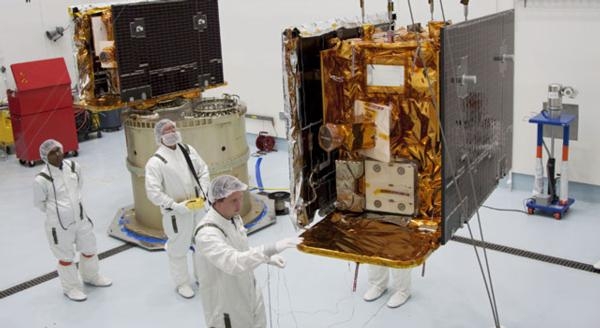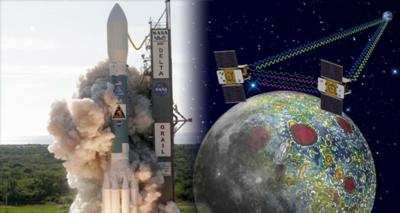Sun, Jan 01, 2012
First of NASA's GRAIL Spacecraft Starts Orbit
NASA has confirmed that the first of two NASA spacecraft to
study the moon in unprecedented detail has entered lunar orbit.
NASA's Gravity Recovery And Interior Laboratory (GRAIL)-A
spacecraft successfully completed its planned main engine burn at 2
p.m. PST (5 p.m. EST) today. As of 3 p.m. PST (6 p.m. EST), GRAIL-A
is in an orbit of 56 miles by 5,197 miles around the moon that
takes approximately 11.5 hours to complete.

"My resolution for the new year is to unlock lunar mysteries and
understand how the moon, Earth and other rocky planets evolved,"
said Maria Zuber, GRAIL principal investigator at the Massachusetts
Institute of Technology in Cambridge. "Now, with GRAIL-A
successfully placed in orbit around the moon, we are one step
closer to achieving that goal."
The next mission milestone occurs tomorrow when GRAIL-A's mirror
twin, GRAIL-B, performs its own main engine burn to place it in
lunar orbit. At 3 p.m. PST (6 p.m. EST) today, GRAIL-B was 30,018
miles from the moon and closing at a rate of 896 mph. GRAIL-B's
insertion burn is scheduled to begin tomorrow, Jan. 1, at 2:05 p.m.
PST (5:05 p.m. EST) and will last about 39 minutes.
"With GRAIL-A in lunar orbit we are halfway home," said David
Lehman, GRAIL project manager at NASA's Jet Propulsion Laboratory
in Pasadena, Calif. "Tomorrow may be New Year's everywhere else,
but it's another work day around the moon and here at JPL for the
GRAIL team."

Once both spacecraft are confirmed in orbit and operating,
science work will begin in March. The spacecraft will transmit
radio signals precisely defining the distance between them as they
orbit the moon in formation. As they fly over areas of greater and
lesser gravity caused by both visible features, such as mountains
and craters, and masses hidden beneath the lunar surface, the
distance between the two spacecraft will change slightly.
Scientists will translate this information into a high-resolution
map of the moon's gravitational field. The data will allow
scientists to understand what goes on below the lunar surface. This
information will increase knowledge of how Earth and its rocky
neighbors in the inner solar system developed into the diverse
worlds we see today.
JPL manages the GRAIL mission for NASA's Science Mission
Directorate at the agency's headquarters in Washington. The GRAIL
mission is part of the Discovery Program managed at NASA's Marshall
Space Flight Center in Huntsville, Ala. Lockheed Martin Space
Systems in Denver built the spacecraft.
More News
Aero Linx: Model Aeronautical Association of Australia MAAA clubs are about fun flying, camaraderie and community. For over 75 years, the MAAA has been Australia’s largest fl>[...]
Touchdown Zone Lighting Two rows of transverse light bars located symmetrically about the runway centerline normally at 100 foot intervals. The basic system extends 3,000 feet alon>[...]
“Discovery and innovation are central to our mission at Virgin Galactic. We’re excited to build on our successful record of facilitating scientific experiments in subor>[...]
How To Get A Story On Aero-TV News/Feature Programming How do I submit a story idea or lead to Aero-TV? If you would like to submit a story idea or lead, please contact Jim Campbel>[...]
Student Pilot Reported That During Rotation, “All Of A Sudden The Back Of The Plane Kicked To The Right..." Analysis: The student pilot reported that during rotation, “>[...]
 ANN's Daily Aero-Linx (05.02.24)
ANN's Daily Aero-Linx (05.02.24) ANN's Daily Aero-Term (05.02.24): Touchdown Zone Lighting
ANN's Daily Aero-Term (05.02.24): Touchdown Zone Lighting Aero-News: Quote of the Day (05.02.24)
Aero-News: Quote of the Day (05.02.24) ANN FAQ: Contributing To Aero-TV
ANN FAQ: Contributing To Aero-TV NTSB Final Report: Cirrus Design Corp SR20
NTSB Final Report: Cirrus Design Corp SR20




